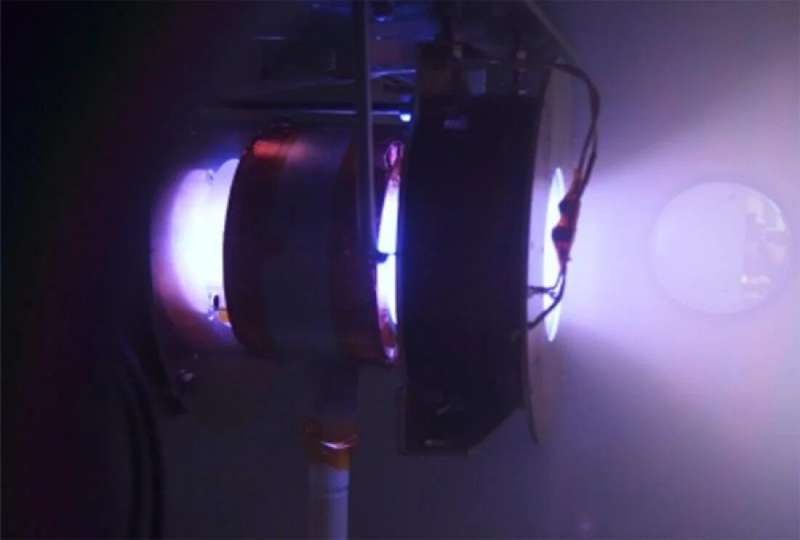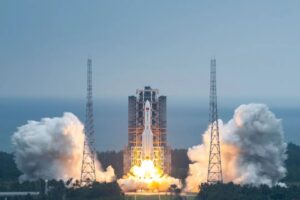Improving the performance of electrodeless plasma thrusters for space propulsion
Friday, 11 November 2022 12:05
A Tohoku University researcher has increased the performance of a high-power electrodeless plasma thruster, moving us one step closer to deeper explorations into space.
Innovations in terrestrial transportation technologies, such as cars, trains, and aircraft, have driven historical technologies and industries so far; now, a similar breakthrough is occurring in space thanks to electric propulsion technology.
Electric propulsion is a technique utilizing electromagnetic fields to accelerate a propellant and to generate thrust that propels a spacecraft. Space agencies have pioneered electric propulsion technology as the future of space exploration.
Already, several space missions have successfully been completed using electric propulsion devices, such as gridded ion thrusters and Hall thrusters. Solar power is converted into thrust energy when the propellant becomes ionized, i.e., a plasma, and gets accelerated by electromagnetic fields.
JPSS-2 deploys solar array after delay
Friday, 11 November 2022 12:03
A weather satellite is in good condition after suffering a problem deploying its solar array immediately after launch Nov. 10.
The post JPSS-2 deploys solar array after delay appeared first on SpaceNews.
China wants to ramp up the launch rate of its Long March 5B rocket
Friday, 11 November 2022 11:45
China is planning to greatly increase the number of launches of its Long March 5B rocket which has created a number of high-profile uncontrolled reentries of its large first stage.
NASA investigating “very minor” Artemis hurricane damage
Friday, 11 November 2022 11:12
A NASA official says that initial inspections of the Space Launch System rocket and Orion spacecraft turned up only “very minor damage” to the vehicle but declined to speculate on any additional delays for the Artemis 1 mission.
ULA launches weather satellite for NOAA and Re-entry test for NASA
Friday, 11 November 2022 10:06 United Launch Alliance has successfully launched the third in a series of polar-orbiting weather satellites for the National Oceanic and Atmospheric Administration (NOAA) at 1:49 a.m. PST Thursday, as well as a NASA technology demonstration misison on a ULA Atlas V rocket from Vandenberg Space Force Base in California.
Mission managers for NOAA's JPSS-2 confirm the satellite is now in Sun
United Launch Alliance has successfully launched the third in a series of polar-orbiting weather satellites for the National Oceanic and Atmospheric Administration (NOAA) at 1:49 a.m. PST Thursday, as well as a NASA technology demonstration misison on a ULA Atlas V rocket from Vandenberg Space Force Base in California.
Mission managers for NOAA's JPSS-2 confirm the satellite is now in Sun NASA views images, confirms discovery of Shuttle Challenger artifact
Friday, 11 November 2022 10:06 NASA leaders recently viewed footage of an underwater dive off the East coast of Florida, and they confirm it depicts an artifact from the space shuttle Challenger.
The artifact was discovered by a TV documentary crew seeking the wreckage of a World War II-era aircraft. Divers noticed a large humanmade object covered partially by sand on the seafloor. The proximity to the Florida Space Coa
NASA leaders recently viewed footage of an underwater dive off the East coast of Florida, and they confirm it depicts an artifact from the space shuttle Challenger.
The artifact was discovered by a TV documentary crew seeking the wreckage of a World War II-era aircraft. Divers noticed a large humanmade object covered partially by sand on the seafloor. The proximity to the Florida Space Coa Hurricane causes only minor damage to Artemis rocket
Friday, 11 November 2022 10:06 After initial visual inspections, NASA said on Thursday that its new mega moon rocket apparently suffered no major damage after Hurricane Nicole hit Florida.
But employees must conduct further checks on site as soon as possible to confirm the initial assessment, said Jim Free, associate administrator at the US space agency.
Free said that NASA teams employing cameras at the launch pad at
After initial visual inspections, NASA said on Thursday that its new mega moon rocket apparently suffered no major damage after Hurricane Nicole hit Florida.
But employees must conduct further checks on site as soon as possible to confirm the initial assessment, said Jim Free, associate administrator at the US space agency.
Free said that NASA teams employing cameras at the launch pad at Kanyini CubeSat coming together in Adelaide
Friday, 11 November 2022 10:06 With its 2023 launch announced by the South Australian government, here's a look inside the Kanyini CubeSat.
It's the multi-million-dollar satellite that will collect invaluable data from space once it takes off into the cosmos.
But the pieces of the puzzle that make up the $6.5 million CubeSat mission, dubbed Kanyini, have been scattered across labs and workshops across South Austra
With its 2023 launch announced by the South Australian government, here's a look inside the Kanyini CubeSat.
It's the multi-million-dollar satellite that will collect invaluable data from space once it takes off into the cosmos.
But the pieces of the puzzle that make up the $6.5 million CubeSat mission, dubbed Kanyini, have been scattered across labs and workshops across South Austra Airbus and Space Compass to target Japanese market for mobile and EO solutions
Friday, 11 November 2022 10:06 Airbus HAPS Connectivity Business (Airbus HAPS) has signed a Letter of Intent (LOI) with Space Compass Corporation of Japan (Space Compass) for a cooperation agreement to service the Japanese market with mobile connectivity and earth observation services from the Stratosphere with Airbus' record breaking Zephyr platform.
Samer Halawi, Chief Executive of Airbus HAPS, commented on the agreem
Airbus HAPS Connectivity Business (Airbus HAPS) has signed a Letter of Intent (LOI) with Space Compass Corporation of Japan (Space Compass) for a cooperation agreement to service the Japanese market with mobile connectivity and earth observation services from the Stratosphere with Airbus' record breaking Zephyr platform.
Samer Halawi, Chief Executive of Airbus HAPS, commented on the agreem NOAA satellite, NASA LOFTID heat shield experiment launched into orbit
Friday, 11 November 2022 10:06 The third of five advanced NOAA satellites launched into orbit early Thursday from California's Vandenberg Space Force Base. The Joint Polar Satellite System-2 will provide a continuous stream of vital weather data.
"The need for advanced satellites, such as JPSS-2, to accurately predict weather and climate has never been greater," said Michael C. Morgan, assistant secretary of commerce
The third of five advanced NOAA satellites launched into orbit early Thursday from California's Vandenberg Space Force Base. The Joint Polar Satellite System-2 will provide a continuous stream of vital weather data.
"The need for advanced satellites, such as JPSS-2, to accurately predict weather and climate has never been greater," said Michael C. Morgan, assistant secretary of commerce Piece of Challenger space shuttle found off Florida coast
Friday, 11 November 2022 10:06 Divers searching for a World War II-era aircraft near the Bermuda Triangle have found a piece of an entirely different sort of vessel: part of the US Challenger space shuttle that exploded soon after takeoff in 1986.
The shuttle burst apart just dozens of seconds after launching from Florida, killing seven crew members, including the teacher Christa McAuliffe who had won a national screening
Divers searching for a World War II-era aircraft near the Bermuda Triangle have found a piece of an entirely different sort of vessel: part of the US Challenger space shuttle that exploded soon after takeoff in 1986.
The shuttle burst apart just dozens of seconds after launching from Florida, killing seven crew members, including the teacher Christa McAuliffe who had won a national screening Ultrathin solar cells promise improved satellite performance
Friday, 11 November 2022 10:06 Most space satellites are powered by photovoltaic cells that convert sunlight to electricity. Exposure to certain types of radiation present in orbit can damage the devices, degrading their performance and limiting their lifetime.
In Journal of Applied Physics, by AIP Publishing, scientists from the University of Cambridge proposed a radiation-tolerant photovoltaic cell design that feature
Most space satellites are powered by photovoltaic cells that convert sunlight to electricity. Exposure to certain types of radiation present in orbit can damage the devices, degrading their performance and limiting their lifetime.
In Journal of Applied Physics, by AIP Publishing, scientists from the University of Cambridge proposed a radiation-tolerant photovoltaic cell design that feature BeiDou making mark among navigation systems
Friday, 11 November 2022 10:06 China's BeiDou Navigation Satellite System (BDS) will be further developed and feature better compatibility and interoperability coordination with the world's other navigation systems, including the GPS system of the United States, Russia's GLONASS system and the Galileo system of the European Union, an official said during the World Internet Conference Wuzhen Summit in Zhejiang province on Wedn
China's BeiDou Navigation Satellite System (BDS) will be further developed and feature better compatibility and interoperability coordination with the world's other navigation systems, including the GPS system of the United States, Russia's GLONASS system and the Galileo system of the European Union, an official said during the World Internet Conference Wuzhen Summit in Zhejiang province on Wedn Viasat and Cobham Satcom announce strategic collaboration on maritime connectivity system
Friday, 11 November 2022 10:06 Viasat Inc. (NASDAQ: VSAT) and Cobham Satcom have announced that the companies are collaborating on a new, advanced satellite connectivity solution for the maritime and energy industries in preparation for the launch of Viasat's next generation satellite constellation, ViaSat-3.
The connectivity system, which will include a portfolio of groundbreaking antenna systems from Cobham Satcom, is
Viasat Inc. (NASDAQ: VSAT) and Cobham Satcom have announced that the companies are collaborating on a new, advanced satellite connectivity solution for the maritime and energy industries in preparation for the launch of Viasat's next generation satellite constellation, ViaSat-3.
The connectivity system, which will include a portfolio of groundbreaking antenna systems from Cobham Satcom, is WA researchers lead the way in hi-tech communications
Friday, 11 November 2022 10:06 The researchers, from the International Centre for Radio Astronomy Research (ICRAR), have been working on this project for two years, with their findings published in the internationally respected science journal, Nature Scientific Reports.
Although optical communications have been in use since the 1980's, government and industry have continued to rely on radio transmission technology in s
The researchers, from the International Centre for Radio Astronomy Research (ICRAR), have been working on this project for two years, with their findings published in the internationally respected science journal, Nature Scientific Reports.
Although optical communications have been in use since the 1980's, government and industry have continued to rely on radio transmission technology in s 